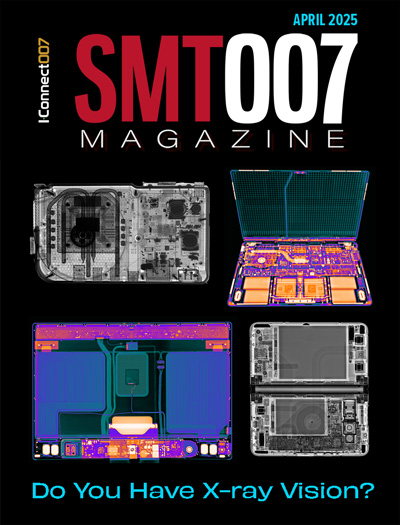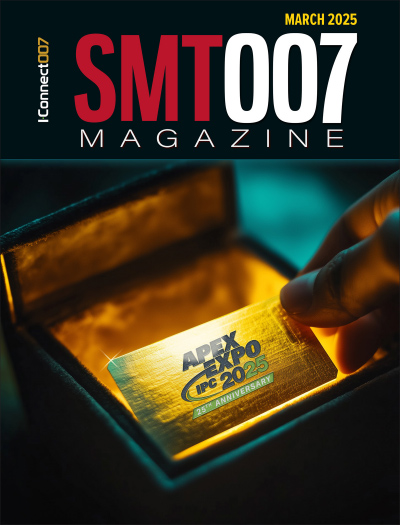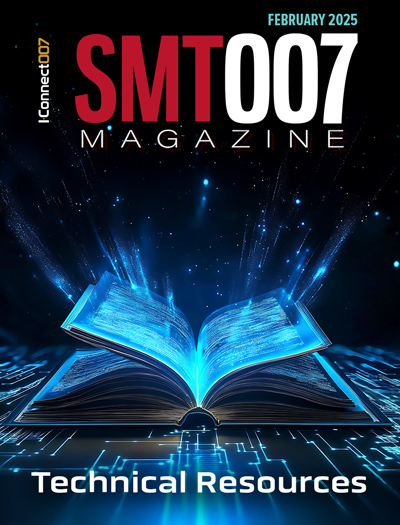-

- News
- Books
Featured Books
- smt007 Magazine
Latest Issues
Current Issue
Do You Have X-ray Vision?
Has X-ray’s time finally come in electronics manufacturing? Join us in this issue of SMT007 Magazine, where we answer this question and others to bring more efficiency to your bottom line.

IPC APEX EXPO 2025: A Preview
It’s that time again. If you’re going to Anaheim for IPC APEX EXPO 2025, we’ll see you there. In the meantime, consider this issue of SMT007 Magazine to be your golden ticket to planning the show.

Technical Resources
Key industry organizations–all with knowledge sharing as a part of their mission–share their technical repositories in this issue of SMT007 Magazine. Where can you find information critical to your work? Odds are, right here.
- Articles
- Columns
Search Console
- Links
- Media kit
||| MENU - smt007 Magazine
Incheon National University Study Pioneers Breakthrough in Wireless Charging Technology
February 21, 2025 | PRNewswireEstimated reading time: 2 minutes
The efficiency of wireless charging systems is limited by power loss occurring due to frequency changes in the resonant circuits that enable power transfer. These necessary modulations reduce electromagnetic interference caused by resonant frequencies on other devices. However, conventional strategies for adapting to changing frequencies are inefficient, cost-prohibitive, and impractical. Now, scientists have designed a resonant tuning rectifier that provides a low-cost, efficient solution to stabilize power delivery in wireless power systems.
Wireless power transfer (WPT) enables device charging without direct physical or wired connections. Resonant circuits are key components of WPT systems that optimize energy transfer from the transmitter to the receiver. In parallel compensated receivers, capacitors balance the inductance of the receiver coil to achieve resonance, reducing circuit impedance, thereby enhancing power transfer.
The electromagnetic fields generated by such receivers can interfere with other electronic devices. Controlling this interference requires modulating the system's operating frequency. However, this modulation creates a mismatch between the modulated and resonant frequencies, severely degrading power output and system efficiency. Current strategies to correct this mismatch rely on additional hardware or complex circuitry, leading to energy loss, complex control settings, and bulkier designs.
In an attempt to find an innovative solution to overcome these challenges, a group of scientists led by Professor Dukju Ahn at Incheon National University, Korea, proposed a resonant tuning rectifier (RTR) for parallel resonant receiver systems. The novel RTR features a minimalist design that synchronizes its operation with the natural rhythm of the system's primary current. "Our RTR does not require extra power components or complex feedback circuitry, rendering it more practical for real-world use," says Prof. Ahn. The study was made available online on May 14, 2024 and was published in Volume 71, Issue 12 of IEEE Transactions on Industrial Electronics on December 01, 2024.
The RTR automatically adjusts effective capacitance to tune the resonant frequency by syncing control signals with the system's current, compensating for differences between intrinsic resonance and modulation periods. Unlike existing methods, it uses a simple sensor coil to extract phase information without impacting performance, eliminating the need for transmitter-receiver communication.
Testing a 2.2 kW prototype for automobile charging showed that the RTR compensates for frequency modulation (80—90 kHz) in 70 ms, maintaining stable power output during misalignment and improving efficiency from 3.5% to 8.1%. Its zero-voltage system optimizes control settings to reduce power loss, offering a simple, cost-effective solution for real-time adaptation and stable power delivery.
"The automatic adjustment of resonant frequency impacts not only wireless charging but also induction heating, plasma generation, and power conversion," explains Prof. Ahn. "With minimal energy loss, high efficiency, stable throughput, a minimalist design, and low system impact, RTR can significantly enhance wireless power system performance," he concludes. As wireless charging becomes more widespread, the proposed RTR offers a promising solution to mitigate existing challenges, making this technology more accessible to everyday users.
Suggested Items
Microsoft’s Brad Smith Urges U.S. Leadership in Quantum Technology
04/29/2025 | I-Connect007 Editorial TeamIn a blog post published on April 28, 2025, Brad Smith, Vice Chair and President of Microsoft, underscores the critical need for the United States to accelerate investment in quantum technology. While public focus remains fixed on artificial intelligence, Smith argues that quantum computing is an equally vital frontier with the power to revolutionize industries and solve complex global challenges across science, medicine, energy, and agriculture.
Ansys Strengthens Collaboration with TSMC on Advanced Node Processes Certification and 3D-IC Multiphysics Design Solutions
04/24/2025 | PRNewswireThrough continued collaboration with TSMC, Ansys announced enhanced AI-assisted workflows for radio frequency (RF) design migration and photonic integrated circuits (PICs), and new certifications for its semiconductor solutions. Together,
Google Signs Taiwan’s First Corporate Geothermal Energy Deal in Asia-Pacific
04/23/2025 | I-Connect007 Editorial TeamGoogle announced that it has entered Taiwan’s first corporate geothermal power purchase agreement (PPA) with Baseload Capital to expand access to around-the-clock clean energy in the Asia-Pacific region and beyond.
PTCRB Certification Adds New IoT Chipset Certification Category, Certifies Sony's Altair ALT1350 CTIA Certification
04/23/2025 | PRNewswireCTIA Certification announced the first PTCRB certified IoT chipset, Sony's Altair ALT1350.
Flex Wins Two 2025 PACE Awards for Innovation in Automotive Compute and Power Electronics
04/22/2025 | PRNewswireFlex was named a two-time 2025 Automotive News PACE Award winner at the awards ceremony on April 15, recognized for its industry-leading Jupiter Compute Platform and Backup DC/DC Converter design platforms.


